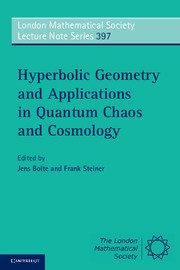Book contents
- Frontmatter
- Contents
- List of Contributors
- Preface
- I Hyperbolic Geometry
- II Selberg's Trace Formula: An Introduction
- III Semiclassical Approach to Spectral Correlation Functions
- IV Transfer Operators, the Selberg Zeta Function and the Lewis-Zagier Theory of Period Functions
- V On the Calculation of Maass Cusp Forms
- VI Maass Waveforms on (Γ0(N), χ) (Computational Aspects)
- VII Numerical Computation of Maass Waveforms and an Application to Cosmology
- Index
Preface
Published online by Cambridge University Press: 05 January 2012
- Frontmatter
- Contents
- List of Contributors
- Preface
- I Hyperbolic Geometry
- II Selberg's Trace Formula: An Introduction
- III Semiclassical Approach to Spectral Correlation Functions
- IV Transfer Operators, the Selberg Zeta Function and the Lewis-Zagier Theory of Period Functions
- V On the Calculation of Maass Cusp Forms
- VI Maass Waveforms on (Γ0(N), χ) (Computational Aspects)
- VII Numerical Computation of Maass Waveforms and an Application to Cosmology
- Index
Summary
Hyperbolic geometry is a classical subject of pure mathematics. It was invented as the first example of a non-euclidean geometry, and hence played a significant role in the development of modern geometry. Soon, however, its manifold connections with other branches of mathematics and science in general became apparent. Subsequently, it played a major role in such diverse fields as number theory, representation theory, complex functions, ergodic theory, dynamical systems, string theory, quantum chaos, and cosmology.
One of the earliest appearances of hyperbolic geometry in applications arose in connection with ergodic theory and dynamical systems, when in 1898 Hadamard realised that the negative curvature of hyperbolic surfaces produced an unstable and erratic behaviour of the geodesic motion. As a specific example, in 1924 Artin considered the geodesic billiard motion in an infinite triangle on the hyperbolic plane. He constructed a symbolic coding of the geodesics in terms of continued fractions and for the first time proved a quasi ergodic behaviour of the geodesics. Subsequently, many developments in ergodic theory and dynamical systems began with studies of geodesic flows on hyperbolic manifolds.
Beginning in the 1940s, a further far reaching development was initiated by the work of Maass, Selberg and others. Maass considered the spectral theory of the Laplace Beltrami operator on a hyperbolic surface, and Selberg discovered a close connection between the eigenvalues of the Laplacian and the closed geodesics on the surface, as expressed by the celebrated Selberg trace formula.
- Type
- Chapter
- Information
- Publisher: Cambridge University PressPrint publication year: 2011

